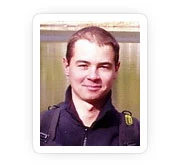Shoulder Alignment in Downward-Facing Dog Pose and Full Arm Balance

External rotation of the humerus in overhead motion is important for gaining the full range of motion and avoiding impingement of the greater tuberosity of the humerus on the undersurface of the acromion. We illustrate this here for two common poses.
Here’s the Anatomy of the Rotator Cuff . . .
The rotator cuff is composed of four muscles. On the front is the subscapularis, which originates from the subscapular fossa of the scapula and inserts onto the lesser tuberosity of the humerus. This muscle acts to internally rotate the humerus at the shoulder.
The supraspinatus originates from the supraspinous fossa of the scapula and inserts onto the greater tuberosity of the humerus. It acts to abduct the humerus and stabilize the humeral head in the glenoid (socket).
The infraspinatus originates from the infraspinous fossa of the scapula and inserts onto the greater tuberosity of the humerus. It acts to externally rotate the humerus and depress the humeral head in the socket.
The teres minor originates from the lateral border of the scapula and inserts onto the greater tuberosity of the humerus. It acts to externally rotate the humerus and has a minor function of adduction.

And the Deltoid . . .
The deltoid muscle is divided into three parts: an anterior or front third, a middle or lateral third, and a posterior third. All three parts of this muscle converge to insert onto the deltoid tuberosity on the side of the humerus.
The anterior part originates from the front of the acromion and the lateral third of the clavicle. It acts to elevate the humerus in the front of the body and synergizes internal rotation of the arm.
The middle third originates from the lateral border of the acromion and acts to abduct the humerus. The posterior third originates from the spine of the scapula and acts to extend the arm back away from the body. It also synergizes external rotation of the arm.

Yoga Anatomy Practice Tips: Downward-Facing Dog Pose
Externally rotate the shoulders in Downward-Facing Dog Pose by engaging the infraspinatus and teres minor muscles. The posterior deltoids contribute to this action. Combine this with pronating the forearms and spreading the weight evenly across the palms of the hands.
Then press forward into the hands as if you were trying to raise them overhead. They obviously will not raise, but this cue draws the trunk deeper into the pose. Externally rotating the shoulders first protects against subacromial impingement.

Full Arm Balance and Yoga Anatomy 
Activate the forearm muscles as described here. Then balance this with external rotation of the humerus, using the infraspinatus and teres minor muscles of the rotator cuff. This creates a coiling effect through the arms as you straighten them (with the triceps).
Would you like more shoulder anatomy & additional practice tips to increase shoulder stability in Downward-Facing Dog Pose? If so, read YogaUOnline’s yoga teacher ed: Dr. Ray Long on Stabilizing the Shoulder in Downward-Facing Dog.
Reprinted with permission from The Daily Bandha
 Author Ray Long MD FRCSC is a board-certified orthopedic surgeon and the founder of Bandha Yoga. Ray graduated from The University of Michigan Medical School with post-graduate training at Cornell University, McGill University, The University of Montreal and Florida Orthopedic Institute. He has studied hatha yoga for over twenty years, training extensively with B.K.S. Iyengar and other leading yoga masters.
Author Ray Long MD FRCSC is a board-certified orthopedic surgeon and the founder of Bandha Yoga. Ray graduated from The University of Michigan Medical School with post-graduate training at Cornell University, McGill University, The University of Montreal and Florida Orthopedic Institute. He has studied hatha yoga for over twenty years, training extensively with B.K.S. Iyengar and other leading yoga masters.
 3d Graphic Designer / Illustrator Chris Macivor has been involved in the field of digital content creation for well over ten years. He is a graduate of Etobicoke School of the Arts, Sheridan College and Seneca College. Chris considers himself to be equally artistic and technical in nature. As such his work has spanned many genres from film and television to video games and underwater imagery.
3d Graphic Designer / Illustrator Chris Macivor has been involved in the field of digital content creation for well over ten years. He is a graduate of Etobicoke School of the Arts, Sheridan College and Seneca College. Chris considers himself to be equally artistic and technical in nature. As such his work has spanned many genres from film and television to video games and underwater imagery.



